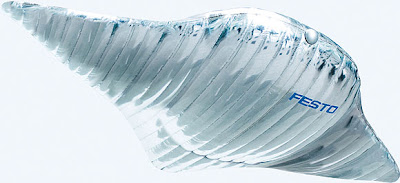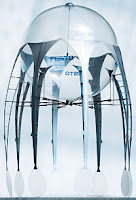Two days ago I wrote about an airship that moves through the air like a fish.
A few readers sent me e-mails to alert me to the fact that this isn’t the first ‘airship’ to mimic the actions of an underwater creature. It seems that a German group, Festo, has produced at least two similar devices. Their Web site highlights what they call a ‘Bionic Learning Network‘, aimed at using nature’s designs to produce machines for human use.
How can bionics be used to improve the efficiency and productivity of automated motion sequences? Festo searches for innovative answers to this question through a diverse range of projects within our Bionic Learning Network. The latest technology from Festo is used in experimental prototypes, such as integrated mechatronic concepts with options for remote maintenance and diagnostics, and the latest piezoelectric valves and electric drives. Festo’s fluidic muscle, a long established component in manufacturing, is proving to be endlessly versatile in ever more amazing applications. The inspiration for the complex drive forms comes from natural phenomena in air and water, but above all from humanity itself.
The Bionic Learning Network is part of our commitment to basic and further technical training. In cooperation with students, prominent technical universities, institutes and development companies, Festo is promoting ideas and initiatives which go beyond the core business of automation and didactics, and which may well give rise to promising areas of application in the future.
Festo’s first design is a manta-ray-like device. They’ve produced it in an underwater and an ‘airship’ design. Their Web site states:
Air-Ray, modelled on the manta ray, is a remote-controlled hybrid construction consisting of a helium-filled ballonet and a beating wing drive. Its lightweight design enables it to “swim” in the sea of air using the lift from the helium in a similar way to the manta ray in water.
Propulsion is achieved by a beating wing drive. The servo drive-controlled wing, which can move up and down, utilises the Fin Ray Effect® and is based on alternate pulling and pushing flanks connected via frames. When pressure is exerted on one edge, the geometrical structure automatically curves against the direction of the influencing force. A servo drive pulls the two flanks alternately in longitudinal direction, thus moving the wing up and down.
The two video clips below show their invention. The first is of their underwater robotic ‘manta’. The second shows the ‘Air-Ray’ flying in an exhibition hall.
Their second design is, of all things, a mechanical jellyfish! They’ve also produced it in two versions, for water and air use. They describe the ‘Aquajelly‘ as follows:
AquaJelly is an artificial autonomous jellyfish in water, a self-controlling system which emulates swarming behaviour. AquaJelly consists of a translucent hemisphere and eight tentacles for propulsion.
At the centre of the AquaJelly is a watertight laser-sintered body. It houses a central electric motor, the two lithium-ion polymer batteries, the recharging control unit and the servo motors for the swash plate.
The air version, ‘AirJelly‘, is described thus:
AirJelly’s environment is the air. Unlike AquaJelly, the remote-controlled jellyfish AirJelly does not swim through water, but instead glides instead through a sea of air thanks to its central electric drive unit and an intelligent, adaptive mechanism. It is able to do so because it consists of a helium-filled ballonet.
AirJelly’s sole source of power is two lithium-ion polymer batteries connected to the central electric drive unit. It transmits the force to a bevel gear and from there to a succession of eight spur gears, which move the eight tentacles of the jellyfish via cranks. Each tentacle is designed as a structure with Fin Ray Effect® . Propulsion of a ballonett by means of peristaltic motion is hitherto unknown in the history of aviation. AirJelly is the first indoor flight object with peristaltic drive. This new drive concept, with propulsion based on the principle of recoil, moves the jellyfish gently through the air.
AquaJelly and AirJelly are shown in the video clip below.
Fascinating stuff! I’d love to know how these designs may figure in future production equipment for real-world use. Come to think of it – if they could deploy a military Unmanned Aerial Vehicle based on a jellyfish, could we arrange for Osama bin Laden to be stung to death by one?
Peter



Let’s just say they are being looked at… One problem with ANY air vehicle is wind velocity and turbulance though…
The AirJelly would be a GREAT cat toy!! 😉
Semper Fi’
DM